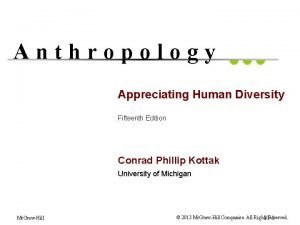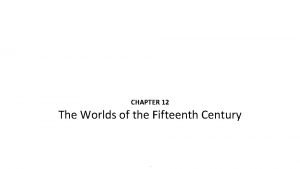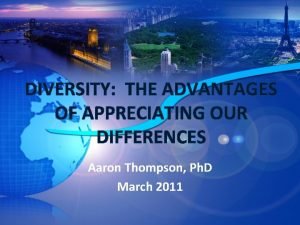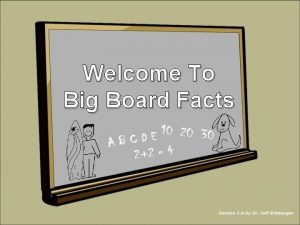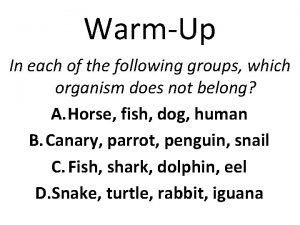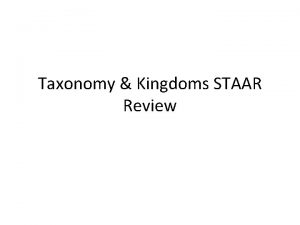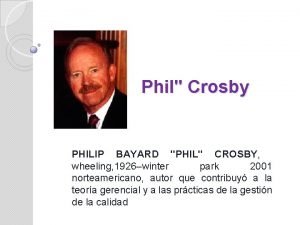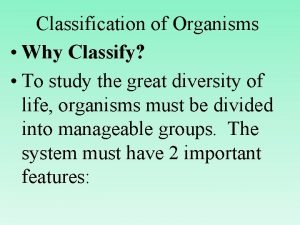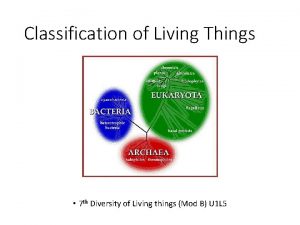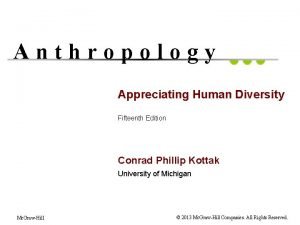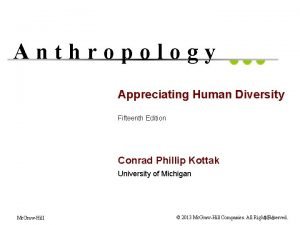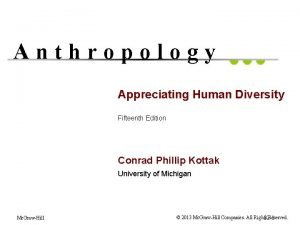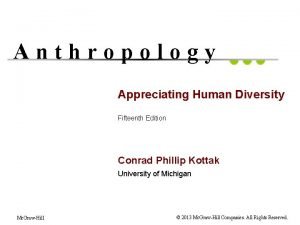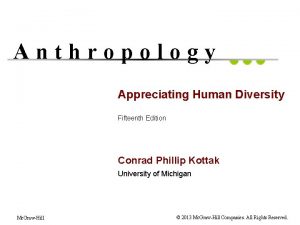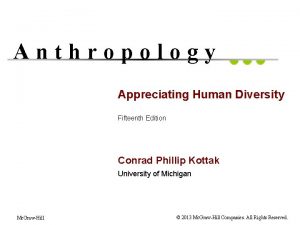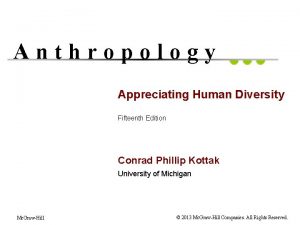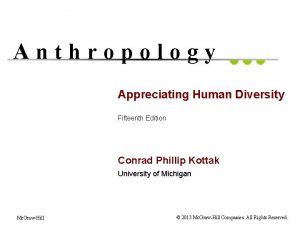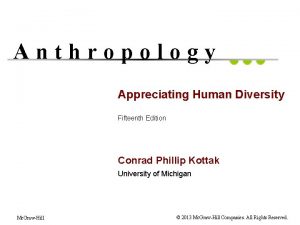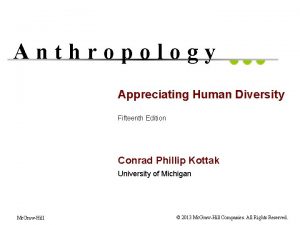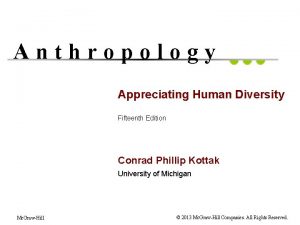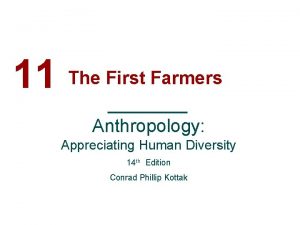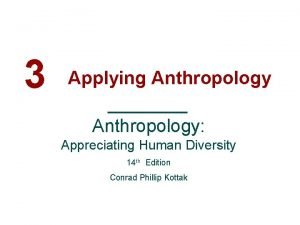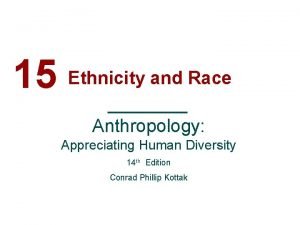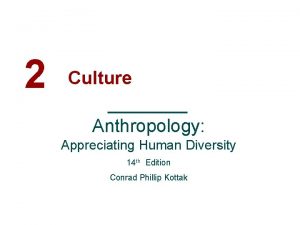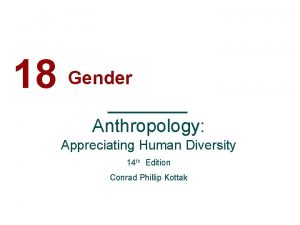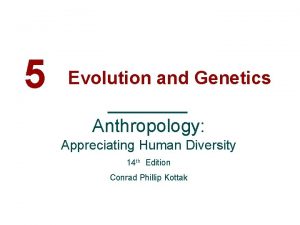Anthropology Appreciating Human Diversity Fifteenth Edition Conrad Phillip


















































- Slides: 50

Anthropology Appreciating Human Diversity Fifteenth Edition Conrad Phillip Kottak University of Michigan Mc. Graw-Hill © 2013 Mc. Graw-Hill Companies. All Rights Reserved.

C H A P T E R GENDER 18 -2

GENDER • • • Sex and Gender Recurrent Gender Patterns Gender Roles and Gender Stratification Gender in Industrial Societies Beyond Male and Female Sexual Orientation 18 -3

GENDER • How are biology and culture expressed in human sex/gender systems? • How do gender, gender roles, and gender stratification correlate with other social, economic, and political variables? • What is sexual orientation, and how do sexual practices vary cross-culturally? 18 -4

SEX AND GENDER Our attributes as adults are determined both by our genes and by our environment during growth and development • Issues of nature versus nurture • Women and men differ genetically • Women – XX chromosomes; • Men – XY chromosomes • Father determines baby’s sex • Chromosomal differences – expressed in hormonal and physiological contrasts 18 -5

Sex and Gender • Sexual dimorphism: marked differences in male and female biology besides the primary and secondary sexual feature; reduction in sexual dimorphism during human evolution • Differences in height, weight, strength, and longevity • Height – men tend to be taller • Weight – men tend to weigh more • Strength – men tend to be stronger • Considerable overlap between the sexes in height, weight, and strength • Longevity – women tend to live longer • Sex differences are biological • Gender refers to the cultural construction of whether someone is male, female, or something else 18 -6

Women Tend to Live Longer 18 -7

SEX AND GENDER • • • Traditional images of masculinity and femininity do not always apply Gender roles: tasks and activities that a culture assigns to the sexes Gender stereotypes: oversimplified, strongly held ideas of characteristics of men and women Gender stratification: unequal distribution of rewards between men and women, reflecting different positions in a social hierarchy Margaret Mead studied three societies: the Arapesh, Mundugumor, and Tchambulie (all on the same island) 18 -8

Sex and Gender Margaret Mead studied three societies: the Arapesh, Mundugumor, and Tchambulie (all on the same island) • Mundugumor and Tchambulie challenged traditional ideas of gender roles • Rosaldo studied Ilongots – gender differences are related to positive cultural value placed on adventure, travel, and knowledge for the external world • Men visit different places and women stay home • Men receive acclaim as a result; women have inferior prestige because they lack external experiences • High male prestige does not necessarily entail economic or political power held by men over their families; in stateless societies, gender stratification is more obvious with regard to prestige than wealth Ann Stoler – the economic determinants of gender status include freedom or autonomy (in disposing of one’s labor and its fruits) and social power (control over the lives, labor, and produce of others 18 -9

Ilongots (Philippines) • - gender differences are related to the positive cultural value placed on adventure, travel, and knowledge for the external world • - Men visit and acquire knowledge of the external world, amass experiences there, and return to express their knowledge and adventures • receive acclaim as a result • - Ilongot women have inferior prestige - lack external experiences on which to base knowledge and dramatic expression. • - High male prestige does not necessarily entail economic or political power held by men over their families. 18 -10

RECURRENT GENDER PATTERNS • • • Ethnologists compare ethnographic data from several cultures (crosscultural) to discover and explain similarities and differences Cross culturally – certain activities can be done by men, women, or both (such as planting and harvesting) These are cultural generalities, not universals (Table 18. 1) • Most societies, men build boats, work with wood, and hunt; women gather firewood, gather plants/vegetables, and prepare food. However, there are exceptions: • Hidatsa women build boats • Pawnee women worked wood • Mbuti pygmy women hunted small, slow animals • Exceptions involve societies or individuals 18 -11

Table 18. 1: Generalities in the Division of Labor by Gender, Based on Data from 185 Societies 18 -12

Recurrent Gender Patterns • • • Swing activities (Table 18. 1) • Assigned to either or both men and women • Most important – planting, tending, and harvesting crops • Table 18. 1 leaves out trade and market activity, which are swing activities Table 18. 1 also leaves out child care (primarily done by women) Subsistence contributions - the subsistence contributions of men and women are roughly equal cross-culturally • In domestic activities and child care, female labor dominates (even in societies where men help out domestically) • Women tend to work more hours than men do (when combining subsistence hours with domestic work hours) • Women are primary caregivers in 2/3 of societies • In U. S. and Canada, some men are primary caregivers • It makes sense for mother to be primary caregiver because of breastfeeding (ensures infant survival) 18 -13

RECURRENT GENDER PATTERNS • Differences in male and female reproductive strategies • Women can have only so many babies; men can keep on reproducing • Men mate, within and outside marriage, more than women do (increases reproductive fitness) • Polygyny- multiple wives; more common than polyandry (multiple husbands) • Men less restricted than women are, although restrictions are equal in about half the societies studied • Double standards that restrict women more than men are one example of gender stratification (unequal distribution of socially valued resources, power, prestige, human rights, and personal freedom) 18 -14

Table 18. 2: Time and Effort Expended on Subsistence Activities by Men and Women 18 -15

Table 18. 3: Who Does the Domestic Work? 18 -16

Table 18. 4: Who Has Final Authority over the Care, Handling, and Discipline of Infant Children (Under Four Years Old)? 18 -17

Table 18. 5: Does the Society Allow Multiple Spouses? 18 -18

Table 18. 6: Is There a Double Standard with Respect to PREMARITAL Sex? 18 -19

Table 18. 7: Is There a Double Standard with Respect to EXTRAMARITAL Sex? 18 -20

GENDER ROLES AND GENDER STRATIFICATION • Sanday: • Economic roles affect gender stratification • Tends to disadvantage women by limiting them sexually, economically, and politically • gender stratification decreased when men and women made roughly equal contributions to subsistence • Foraging societies – less gender stratification • Stratification in most marked when men contributed much more to diet than women • In some societies, gathering (done by women) provides more food than hunting and fishing • When gathering is prominent, gender status tends to be more equal 18 -21

GENDER ROLES AND GENDER STRATIFICATION • Domestic-public dichotomy: • Domestic – pertaining to the home • Public – outside world; politics, trade, warfare, or work • Domestic-public dichotomy: strong differentiation between home and the outside world • When domestic and public spheres are clearly separated, public activities have greater prestige than domestic ones • Dichotomy promoted gender stratification because men are usually the ones active in the public domain; women’s activities tend to be closer to home (due to pregnancy, lactation, and child care) • Domestic-public dichotomy is less developed among foragers, so less gender stratification 18 -22

Domestic – Public Dichotomy 18 -23

GENDER ROLES AND GENDER STRATIFICATION • Greater size, strength, and mobility of men led to exclusive service in roles of hunters and warriors; leads to gender stratification • Pregnancy, lactation and breastfeeding keep women from being primary hunters in foraging societies • The Agta (exception) • Women gather and hunt with dogs • Carry children with them 18 -24

REDUCED GENDER STRATIFICATION— MATRILINEAL, MATRILOCAL SOCIETIES • Cross-cultural variation in gender status related to rules of descent and postmarital residence • Matrilineal descent: • Common among horticulturalists (grow plants) • Descent traced through females • Matrilocal – residence with a wife’s relatives after marriage • Children join mother’s group at birth • Patriliny and patrilocality: • Keeps male relatives together; advantageous in times of warfare • Alliances between men have grown throughout their lives • Matrilineal/matrilocal systems tend to occur where population pressure on strategic resources is minimal and warfare is infrequent 18 -25

REDUCED GENDER STRATIFICATION • Women tend to have high status in matrilineal, matrilocal societies • Due to: descent group membership, succession to political positions, allocation of land, and social identity all come from the female line • Matrilocality created solidarity clusters of female kin • Women had considerable influence beyond the household • Women are basis of entire social structure • Although public authority may be (or appear to be) assigned to men, much of the power and decision making may actually belong to the senior women 18 -26

MATRIARCHY • If patriarchy is political system ruled by men, the is matriarchy a political system run by women? • Matriarchy – women play a more prominent role than men do in political and social organization • Not mirror image of patriarchy; not “run by women” Peggy Sanday (2002): Minangkabau of Indonesia 18 -27

Matriarchy • • Peggy Sanday (2002): Minangkabau of Indonesia • a matriarchy because women are the center, origin, and foundation of the social order • Women are not disproportionately more powerful than men • Women: • Associated with central pillar of the traditional house (oldest house in village) • Ceremonies – women are addressed by term meaning “Queen Mother” • Control land inheritance • Matrilocal • Wedding ceremony – wife and kin collect husband escort him to wife’s home • Divorce – man takes his things and leaves Despite special position of women, matriarchy is not the equivalent of female rule; all decision making should be done by consensus 18 -28

INCREASED GENDER STRATIFICATION— PATRILINEAL-PATRILOCAL SOCIETIES • Patrilineal-patrilocal complex: • male supremacy is based on patrilineality, patrilocality, and warfare • Patrilineal descent: descent traced through men • Patrilocality – woman moves to her husband’s village after marriage • Spread of patrilineal-patrilocal complex is linked to pressure on resources • As resources become more scarce, warfare often increases • Warfare favors patrilineal-patrilocal complex • Keeps related men together where they make strong allies in battle 18 -29

INCREASED GENDER STRATIFICATION • • • Patrilineal-patrilocal complex tends to have sharp domestic-public dichotomy • Many men use public roles in warfare and trade and greater prestige to symbolize and reinforce devaluation or oppression of women P-p complex tends to enhance male prestige opportunities and result in relatively high gender stratification Characterizes many societies in highland Papua, New Guinea • Women do most of cultivation of subsistence crops, cooking, and raising pigs (main domesticated animal); largely excluded from more prestigious roles in pubic domain • Men dominate public domain by growing and distributing prestige crops, preparing food for feasts, arranging marriages, trading pigs, and overseeing their use in ritual (sells the pigs that women raised) 18 -30

Increased Gender Stratification • • Densely populated areas (Papua, New Guinea) – Men associate women with danger and pollution; high gender stratification • Women do cultivation and cooking and raising pigs • Men dominate pubic domain by growing prestige crops, preparing food for feasts, arranging marriages, trading pigs, rituals… • fear female contact, including sexual • Men segregate themselves in men’s houses • Hide ritual objects • Delay marriage; some never marry Sparsely populated areas (recently settled areas) – lacks taboos on malefemale contacts; reproductive rates are higher 18 -31

PATRIARCHY AND VIOLENCE • • Patriarchy: political system ruled by men in which women have inferior social and political status, including basic human rights • Barbara Miller describes rural Northeastern India women as “the endangered sex” • From tribal societies to state societies Societies that feature full-fledged patrilineal-patrilocal complex, replete with warfare and intervillage raiding, also typify patriarchy Violent practices toward females such as dowry murders, female infanticide, and clitoridectomy Although domestic abuse exists all over the world, abuse is more common when women are separated form their supportive kin ties and are thus, more isolated 18 -32

PATRIARCHY AND VIOLENCE • • Gender stratification typically reduced in societies in which women have prominent roles in the economy and social life Spread of women’s rights and human rights movements: • Attention to domestic violence and abuse of women has increased • Laws have been passed • Mediating institutions have been established • U. S. and Canada: • Shelters for victims of domestic abuse have been developed • Brazil: • Female run police stations for battered women • India: • A series of “Ladies only” facilities, including trains and entry lines for women who had experienced harassment or violence 18 -33

GENDER IN INDUSTRIAL SOCIETIES • Domestic-public dichotomy influences gender stratification in industrial societies (i. e. United States, Canada…) where gender roles are changing rapidly • The “traditional” idea that a “woman’s place is in the home” developed among middle and upper class Americans as industrialism spread after 1900 • Before 1900 s, pioneer women were recognized as fully productive workers in farming and home industry 18 -34

Gender in Industrial Societies • 1890 s – over one million women workers held menial, repetitious, and unskilled factory positions • Men, women, children, freed slaves – flocked to factories as wage workers • Early 1900 s, wave of European immigrants • Willing to work for lower wages than American born men so they got factory jobs that would have gone to women • Machine tools and mass production further reduced need for female labor • Idea that women were biologically unfit for factory work gained ground; lowered women’s status 18 -35

Gender in Industrial Societies • Maxine Margolis (2000) - Gendered work, attitudes, and beliefs have varied in response to American economic needs • Examples • : Wartime • Shortages of men • Patriotic duty of women to work outside the home • Idea that women are biologically unfit for physical work faded • Inflation and culture of consumption have spurred female employment (families need two paychecks) • Changes in economy led to changes in attitudes toward and about women 18 -36

GENDER IN INDUSTRIAL SOCIETIES • Since WWII – baby boom, industrial expansion, and increase in female workers • Female occupations – clerical work, teacher, nursing; pays less than male dominated fields • Employers found they could increase profits by paying women lower wages than they would have to pay returning male veterans • Economic changes paved way for women’s movement • National Organization for Women – 1966 • Movement promoted expanded work opportunities, including goal of equal pay for equal work • Between 1970 and 2010, female percentage of American workforce rose from 38% to 47% • Not only single women; many are wives and mothers • Dramatic change in behavior and attitude • As women increasingly work outside the home, ideas about gender roles of males and females changed 18 -37

Table 18. 8: Cash Employment of U. S. Mothers, Wives, and Husbands, 1960– 2010 18 -38

THE FEMINIZATION OF POVERTY • • Increasing representation of women and their children among America’s poorest people • Percentage of single-parent (usually female-headed) households increasing worldwide • Median income for single mother household $32, 031 • Median income for married couple household is $72, 751 • Married couple households earn more than twice as much as single mother • Households headed by single mom have less income than those headed by single dad • Globally, female headed households are poorer than are those headed by men • U. S. has highest percentage of single parent households • More than half the poor children in the U. S. live in families headed by women; becomes cycle of poverty (poor living standards and poor health) One way to improve situation of poor women is to encourage them to organize • Helps women mobilize resources, increase confidence, and decrease dependence; helps to improve their social and economic situation 18 -39

Table 18. 9: Median Annual Income of U. S. Households by Household Type, 2009 18 -40

Table 18. 10: Percentage of Single-Parent Households, Selected Countries, 1980– 81 and 2008 18 -41

WORK AND HAPPINESS • Correlation between rankings of happiness and of women’s work outside the home • Of 13 countries with greatest female labor force participation, 10 ranked among world’s happiest • Denmark – ranked first (75% of women worked) • Turkey – ranked lowest (31% of women worked) • U. S. – ranked 12 th • Positive correlation between women working and happiness • Most countries listed among happiest also have higher standard of living and more secure government safety net 18 -42

Table 18. 11: Female Labor Force Participation by Country, 2008 18 -43

BEYOND MALE AND FEMALE • Contemporary U. S. categories includes individuals who self-identify using such labels as transgender, intersex, third gender, and transsexual; many societies recognize more than two genders • Transgender: social category that includes individuals who may or may not contrast biologically with ordinary males and females • Contradict dominant male/female gender distinctions by being part male and part female, or neither male nor female • Must expand beyond binary categories • Sex – biological aspect • Gender – socially constructed • Transgender – includes those with no apparent biological roots as well as those with biological basis • Intersex: conditions involving discrepancy between external and internal genitals; hermaphrodite 18 -44

Beyond Male and Female 18 -45

BEYOND MALE AND FEMALE Transgender is a Western category that encompasses a variety of persons whose gender performance and identity contradict or defy a binary gender structure. People construct their identities in society Many individuals with and without biological conditions see themselves as male or female Self-identified transgender people tend to be individuals whose gender identity contradicts their biological sex at birth and the gender identity that society assigned to them in infancy Fear and ignorance related to diversity in gender fuels discrimination Gender diversity exists in many societies and has taken many forms across cultures throughout history (i. e. hijras in India) Transvestites – men dressed as women; represent the most common alternative gender category 18 -46

SEXUAL ORIENTATION • Sexual orientation refers to person’s habitual sexual attraction to, and sexual activities with, persons of the opposite sex (heterosexuality), same sex (homosexuality), and both sexes (bisexuality). • Asexuality – refers to indifference toward members of either sex • One’s gender identity does not dictate one’s sexual orientation • All four forms are found throughout world • Each holds different meanings for individuals and groups • Example: male/male relationships may be a private affair or a public, socially sanctioned event • In U. S. , tendency to see sexual orientation as fixed and biologically based • Sexual norms vary from culture to culture and through time 18 -47

Sexual Orientation • All human activities, including sexual preferences, are so some extent learned, malleable, and at least partly culturally constructed • No one knows for sure why sexual differences exist • Part appears to be biological, reflecting genes and hormones • Part may have to do with experiences during growth and development • Whatever the reason, culture plays a role in molding sexual urges toward a collective norm • Sexual norms vary considerably cross-culturally and through time 18 -48

SEXUAL ORIENTATION • In 1/3 of the societies studied (37 out of 76), sex acts involving people of the same sex were absent, rare, or secret (Ford and Beach, 1951) • In others, various forms of same-sex sexual activity considered normal and acceptable (2/3 of those societies) • Sudanese Azande • Etoro of Papua New Guinea • Flexibility in sexual expression seems to be an aspect of our primate heritage • Chimps and other primates participate in masturbation and same sex relations 18 -49

Figure 18. 2: The Location of the Etoro, Kaluli, and Sambia in Papua New Guinea 18 -50
 Anthropology appreciating human diversity
Anthropology appreciating human diversity Performance appraisal in human resource management
Performance appraisal in human resource management Management fifteenth edition
Management fifteenth edition University physics with modern physics fifteenth edition
University physics with modern physics fifteenth edition 14 course french classical menu
14 course french classical menu The worlds of the fifteenth century
The worlds of the fifteenth century Chapter 12 the worlds of the fifteenth century
Chapter 12 the worlds of the fifteenth century What does rally round the flag mean
What does rally round the flag mean Appreciating poetry notes
Appreciating poetry notes Appreciating drama
Appreciating drama Benefits of appreciating differences
Benefits of appreciating differences Why is genetic diversity important
Why is genetic diversity important Ecosystem jigsaw activity
Ecosystem jigsaw activity Using mis (10th edition) 10th edition
Using mis (10th edition) 10th edition Using mis (10th edition) 10th edition
Using mis (10th edition) 10th edition King phillip came over for good soup
King phillip came over for good soup King phillip came over from great spain
King phillip came over from great spain Dear king phillip came over
Dear king phillip came over King phillip came over from great spain
King phillip came over from great spain Dear king phillip came over
Dear king phillip came over King phillip came over for good soup
King phillip came over for good soup Philip bayard crosby
Philip bayard crosby Phillip gilley
Phillip gilley Eubacteria examples with scientific names
Eubacteria examples with scientific names Deacon phillip
Deacon phillip King phillip acronym
King phillip acronym Dear king phillip came over
Dear king phillip came over Dear king phillip came over
Dear king phillip came over King phillip came over from great spain
King phillip came over from great spain Levels of classification
Levels of classification Bufonaria borisbeckeri
Bufonaria borisbeckeri Alexander the great's timeline
Alexander the great's timeline Phillip zimbardo
Phillip zimbardo Philip larkin they mess you up
Philip larkin they mess you up Philips 6/6 dinamica de grupos
Philips 6/6 dinamica de grupos Philip scherrer
Philip scherrer Gunho sohn
Gunho sohn Zoo by edward d. hoch theme
Zoo by edward d. hoch theme Philipp lah
Philipp lah The cafe excerpt from the island by gary paulsen answer key
The cafe excerpt from the island by gary paulsen answer key Airbnb stayz
Airbnb stayz Science experiment risk assessment
Science experiment risk assessment Phillip garber
Phillip garber Phillip crisp
Phillip crisp Phillip juengst
Phillip juengst King phillip came over for good spaghetti
King phillip came over for good spaghetti Phillip crisp
Phillip crisp Phillip crisp
Phillip crisp Phillip leung
Phillip leung Phillip gardiner tobacco
Phillip gardiner tobacco Phillip burns
Phillip burns
